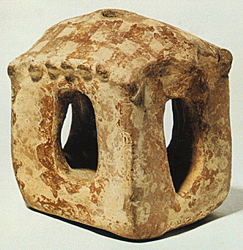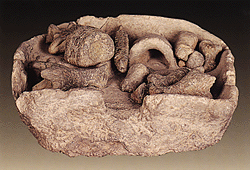 
Figurine art of the Neolithic Period produced, besides anthropomorphic and zoomorphic figurines, clay house models, which have provided indicative information on the architecture of the period. They are not faithful copies of houses, but abstract depictions of the vital core element of every Neolithic settlement. The massive appearance of house models during the Middle Neolithic, a period during which the type of house with stone foundations and mud-brick walls (of unfired clay bricks) was established in Thessaly, denotes a deliberate reference to this new technological and social fact. Their height ranges between 5 to 20 centimetres and are either with a roof or without a roof. Both models have a square or rectangular room and are usually houses with a ground floor, while the one-storey houses depicted, are known as "Tsangli type" houses. |
|
The models with a roof are empty within and have narrow rectangular openings on their four sides, representing doors and windows. The roofs of the models are slightly gabled with a circular opening in the middle, suggesting the existence of a hearth in the interior of the houses. The facade of some of them is decorated with relief or sculpted animal figures. Isolated specimens with solid sides and an opening on the roof probably represent granaries. Other architectural parts and construction details, such as roof beams, are depicted with painted, relief or incised designs. Models with a roof originate almost exclusively from Thessaly and date to the Middle Neolithic Period. |

Models made without a roof aimed to show the interior of the house. They date to the Late Neolithic and originated from Thessaly and Macedonia. The most representative specimens come from Sitagroi-Macedonia and Platia Magoula Zarkou-Thessaly. In the interior of houses the hearth and the "bench" (bed) are depicted, while in the specimen from Platia Magoula Zarkou the eight members of the family are also included: grandparents, parents and four children! |
| From settlements of the Late and the Final Neolithic clay miniatures
of essential elements of the neolithic household, such as ovens and tables,
are also represented.
The discovery of models close to the hearth or the central post of the roof, as well as beneath the floor (Platia Magoula Zarkou) is considered symbolic and researchers have linked their position with foundation offerings and supplications for the protection of the household. |